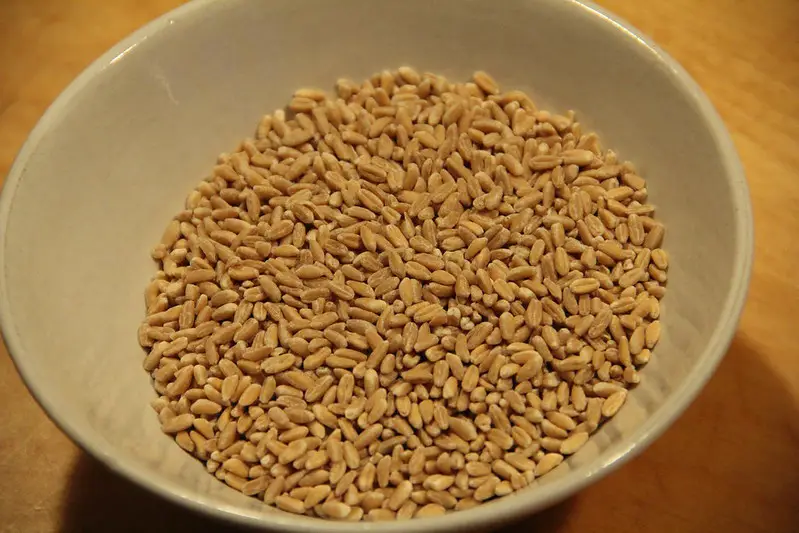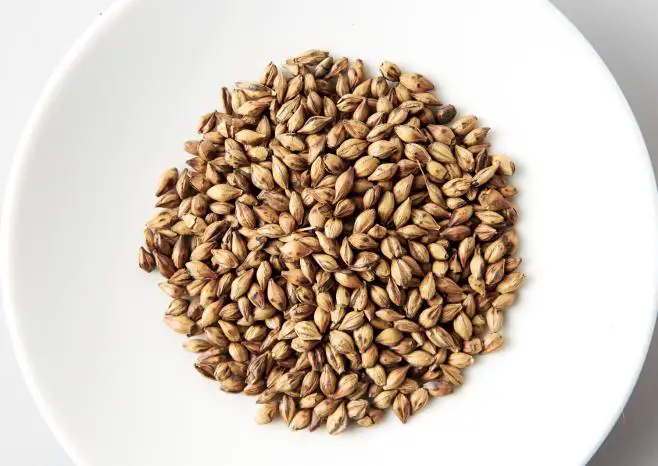Farro and barley are ancient grains, but differ in taste and texture. Farro is nuttier with a chewy texture, while barley is softer and milder.
What is Farro?

Farro, also known as emmer wheat, is an ancient grain that has been cultivated for thousands of years. It has a nutty flavor and a slightly chewy texture. Farro is rich in fiber, protein, vitamins, and minerals. It is a good source of antioxidants and has a lower gluten content compared to modern wheat varieties.
History and Origins of Farro
Farro, in all its rich history and fascinating origins, can be traced back thousands of years to ancient civilizations like the Babylonians, Egyptians, and Romans. These cultures recognized its nutritional value and versatility in cooking, cultivating it as a staple grain. The Fertile Crescent, encompassing present-day Iraq, Iran, Syria, and Turkey, provided the ideal conditions for farro to thrive, leading it to become an indispensable crop in the ancient world.
What truly set farro apart was its ability to withstand harsh climates and poor soil conditions, making it a reliable food source for civilizations facing agricultural challenges. Its cultivation and consumption spread across Europe, with different regions developing their own unique varieties. Even today, farro is grown and cherished in various parts of the world, particularly Italy, where it plays a prominent role in traditional dishes like risotto and salads.
Delving into the history and origins of farro not only grants us valuable insight into its cultural significance and culinary legacy but also allows us to appreciate the ancient wisdom of civilizations that recognized its nutritional benefits and adaptability. By incorporating farro into our modern diets, we not only forge a connection to our past but also embrace a nourishing option for wholesome and delicious meals.
Nutritional Profile of Farro
Farro is a nutritious grain that offers numerous health benefits. Here is a table outlining the nutritional profile of farro:
| Nutrient | Amount per 100g |
| Calories | 337 |
| Protein | 14.6g |
| Carbohydrates | 70g |
| Fiber | 10.3g |
| Fat | 2.3g |
| Calcium | 35mg |
| Iron | 1.5mg |
| Magnesium | 68mg |
| Phosphorus | 227mg |
| Potassium | 370mg |
Farro has a nutritious profile that includes a good amount of calories, protein, carbohydrates, fiber, and fat. It is also rich in essential minerals such as calcium, iron, magnesium, and potassium. The high fiber content helps regulate digestion and promotes a healthy gut. Farro contains antioxidants that support overall well-being.
When incorporating farro into your diet, consider its nutritional profile to meet your specific dietary needs and health goals. Its high protein content makes it an excellent choice for vegetarians and vegans aiming to increase their protein intake. It can also serve as a healthy substitute for refined grains in various recipes, including salads, soups, and grain bowls.
Incorporating farro into your diet can enhance your overall nutritional intake and support a healthy lifestyle. Remember to consult with a healthcare professional or nutritionist before making any significant dietary changes.
What is Barley?

Barley is one of the oldest cultivated grains in the world. It has a mild, slightly nutty flavor and a chewy texture. Barley is also high in fiber, protein, vitamins, and minerals. It is known for its heart-healthy benefits, as it may help reduce cholesterol levels and improve digestion.
History and Origins of Barley
Barley, a widely consumed cereal grain, has a long and fascinating history. Its origins can be traced back approximately 10,000 years to the Fertile Crescent region of the Middle East.[1] Throughout history, barley cultivation spread to various parts of the world, including Egypt, Greece, and Rome, playing a crucial role in the development of ancient civilizations.[2]
Barley’s ability to grow in diverse climates and soils made it an important crop for farmers. Its resilient nature allowed it to withstand harsh conditions, making it a reliable food source even during droughts or famines.[3] Apart from its versatility, barley was used for breadmaking, brewing beer, and feeding livestock.
In addition to its historical significance, barley offers numerous nutritional benefits. It is rich in dietary fiber, vitamins, and minerals such as manganese, selenium, and phosphorus.[4] Barley also contains antioxidants that contribute to overall health and well-being.
A captivating story that showcases the rich history and origins of barley revolves around the ancient Egyptians. They held barley in high regard, considering it a sacred grain. Not only was it used as a form of currency, but its cultivation was also heavily regulated by the Egyptian government. This exemplifies the profound impact barley had on ancient societies and emphasizes its importance as a staple crop.
Understanding the history and origins of barley allows us to appreciate this remarkable grain and its significance in human civilization. Whether enjoyed in soups, salads, or as a side dish, barley remains a versatile and nutritious food that has withstood the test of time.
Nutritional Profile of Barley
The nutritional profile of barley, often referred to as the nutritional profile of barley, is truly impressive. This remarkable grain is packed with essential nutrients that contribute to overall health and well-being. To provide a clear idea of its nutritional components, here is a table outlining the key nutrients found in barley:
| Nutrient | Amount per 100g |
| Calories | 354 |
| Protein | 12g |
| Carbohydrates | 73g |
| Fiber | 17g |
| Fat | 2g |
| Vitamin B6 | 0.3mg (15% DV) |
| Iron | 2.5mg (14% DV) |
| Magnesium | 133mg (33% DV) |
| Phosphorus | 264mg (26% DV) |
| Potassium | 452mg (13% DV) |
| Zinc | 2.8mg (19% DV) |
Barley is a highly nutrient-dense grain and an excellent source of dietary fiber, making it an ideal choice for aiding digestion and maintaining a healthy weight. Moreover, it is abundant in vital vitamins and minerals, including vitamin B6, iron, magnesium, phosphorus, potassium, and zinc. These nutrients play crucial roles in various bodily functions such as energy production, red blood cell formation, bone health, and immune function.
Incorporating barley into your diet can significantly contribute to a well-balanced and nutritious eating plan. This versatile grain can be used in a variety of dishes, including soups, salads, stews, and pilafs, adding both heartiness and satisfaction to your meals while providing valuable nutrients. By embracing barley, you not only boost your overall health but also enhance your culinary repertoire.
Pro-tip: For maximum nutritional benefits, opt for whole-grain barley instead of refined varieties. This ensures that you retain the natural fiber and nutrient content, amplifying the goodness of this remarkable grain.
Differences Between Farro and Barley
Appearance and Texture
The appearance and texture of farro and barley can be distinguished through several key characteristics:
1. Size: Farro grains are larger and have a more elongated shape compared to barley grains. Barley grains, on the other hand, are smaller and rounder.
2. Color: Farro grains have a variety of colors, ranging from light brown to dark brown, while barley grains are typically pale yellow or ivory in color.
3. Texture: Farro has a chewy and nutty texture, with a slight crunchiness. Barley, on the other hand, has a softer texture with a slightly chewy bite.
4. Consistency: When cooked, farro retains its shape and texture, maintaining a slightly firm bite. Barley becomes soft and plump when cooked, often resembling a creamy consistency.
5. Cooking time: Farro usually takes longer to cook compared to barley. It requires more time and water to soften its texture, while barley cooks relatively faster.
6. Culinary uses: Due to its chewy texture, farro is commonly used in salads, stews, and pilafs. Barley is often used in soups, risottos, and as a grain side dish.
It’s important to consider these differences in appearance and texture when deciding which grain to use in various recipes. Whether you prefer the chewiness of farro or the softness of barley, both grains offer unique characteristics that can enhance your culinary experience.
Taste and Flavor
The taste and flavor of farro and barley can be differentiated based on their distinct characteristics.
Farro has a nutty taste and a chewy texture, which adds a delightful crunchiness to dishes. It has a slightly sweet flavor that enhances the overall taste of the dish. On the other hand, barley has a more pronounced nutty taste and a chewy texture similar to farro. Barley has a slightly earthy flavor, which gives it a unique taste. It adds depth and richness to dishes, especially in soups and stews.
Both farro and barley have distinct taste profiles that contribute to the overall flavor of a dish. Depending on personal preference and the desired flavor profile of a recipe, one can choose between farro’s slightly sweet and nutty taste or barley’s earthy and nutty flavor. Incorporating these grains into various recipes can bring out their unique tastes, enhancing the overall culinary experience.
Culinary Uses
The culinary uses of both farro and barley can vary depending on the dish and the desired texture. Here is a comparison of their culinary uses:
| Farro | Barley |
| 1. Salads: Farro is commonly used in salads, either as the main ingredient or as a grain to add texture and substance. | 1. Soups and stews: Barley is often used in hearty soups and stews, as it adds a chewy texture and absorbs flavors well. |
| 2. Risotto-style dishes: Farro can be cooked similarly to risotto, creating a creamy and flavorful dish. | 2. Pilafs and grain bowls: Barley is great for pilafs and grain bowls due to its ability to absorb flavors and maintain a slightly chewy texture. |
| 3. Stuffings: Farro can be used as a stuffing for vegetables or meats, adding a nutty flavor and pleasant crunch. | 3. Breads and baked goods: Barley can be ground into flour and used in baking, adding a distinct flavor to breads, cakes, and cookies. |
| 4. Side dishes: Farro can be served as a simple side dish, seasoned with herbs and spices to complement the main course. | 4. Beer and beverages: Barley is a primary ingredient in beer production and can also be used in the production of non-alcoholic malt beverages. |
As you can see, both farro and barley have versatile culinary uses, allowing you to experiment with different dishes and flavors.
Cooking Methods
When it comes to cooking farro and barley, there are several cooking methods you can use to prepare these grains. Consider the following cooking methods:
1. Boiling: Boiling is a popular technique for cooking both farro and barley. Simply add the grains to a pot of boiling water and cook until they reach the desired tenderness. The cooking time may vary depending on the type of grain and your preferred texture.
2. Steaming: Steaming is another method that can be employed to cook farro and barley. Place the grains in a steamer basket and steam them over simmering water until they are cooked to your liking. This method helps to preserve the grains’ texture and nutrients.
3. Simmering: Simmering is a gentle and slow cooking method suitable for farro and barley. Add the grains to a pot with enough liquid and simmer them until they are soft and fully cooked. This technique allows the grains to absorb the flavors of the cooking liquid.
4. Pressure cooking: For a faster cooking method, the use of a pressure cooker is recommended for farro and barley. This technique significantly reduces the cooking time and helps to soften the grains more quickly. Follow the manufacturer’s instructions for cooking times and liquid ratios.
Remember to rinse the grains before cooking and adjust the cooking time and liquid amounts according to your desired texture. Try different methods to find the one that suits you best and enjoy experimenting with these grains in your favorite recipes.
Nutritional Differences
The nutritional differences between farro and barley can be compared in the following table:
| Nutrient | Farro | Barley |
|---|---|---|
| Calories | 170 per 1/4 cup | 160 per 1/4 cup |
| Protein | 7 grams per 1/4 cup | 4 grams per 1/4 cup |
| Fiber | 3 grams per 1/4 cup | 2 grams per 1/4 cup |
| Fat | 1 gram per 1/4 cup | 0 grams per 1/4 cup |
| Carbohydrates | 34 grams per 1/4 cup | 36 grams per 1/4 cup |
| Iron | 1.5 milligrams per 1/4 cup | 0.8 milligrams per 1/4 cup |
| Calcium | 11 milligrams per 1/4 cup | 7 milligrams per 1/4 cup |
Farro and barley have nutritional differences. Farro contains slightly more calories, protein, fiber, and calcium compared to barley. It also has more iron and carbohydrates. On the other hand, barley has slightly less fat and fewer calories compared to farro. Both grains are nutritious and provide essential nutrients, but the specific nutritional composition may vary depending on the brand or type. It is important to note that these values are approximate and can vary slightly.
Considering the nutritional differences, individuals can choose between farro and barley based on their specific dietary needs and preferences. For example, those looking for higher protein and fiber content may prefer farro, while individuals focusing on lower calorie and fat intake may opt for barley. It is always recommended to consult a healthcare professional or registered dietitian for personalized dietary advice.
Similarities Between Farro and Barley
While Farro and Barley have distinct differences, they also share several similarities:
- Whole Grains: Both Farro and Barley are whole grains, which means they retain their bran, germ, and endosperm, providing a higher nutritional value compared to refined grains.
- Nutritional Content: Both grains are excellent sources of fiber, providing digestive benefits and promoting a feeling of fullness. They also contain essential minerals such as magnesium, phosphorus, and iron.
- Versatility in Cooking: Farro and Barley can be used in a variety of dishes, including soups, salads, pilafs, and risottos. They have a hearty texture and can absorb flavors well.
- Cooking Methods: Both grains require cooking in liquid, typically water or broth, to soften their texture. They can be cooked on the stovetop, in a rice cooker, or even in an Instant Pot.
- Nutty Flavor: Farro and Barley have a nutty flavor profile, which adds depth to dishes and pairs well with various ingredients.
- Health Benefits: Both grains offer health benefits such as promoting heart health, regulating blood sugar levels, and supporting healthy digestion due to their fiber content.
- Substitutability: Farro and Barley can be used as substitutes for each other in recipes, especially when it comes to salads, pilafs, and grain-based side dishes.
Despite their similarities, it’s important to note that Farro and Barley have distinct characteristics and flavors, so experimenting with both grains can add variety to your meals and expand your culinary repertoire.
Frequently Asked Questions
What’s the difference between farro and barley?
Farro and barley are both ancient grains that have been used for thousands of years. Farro is a type of whole-grain wheat that originated in the Fertile Crescent, while barley is a versatile grain that has been cultivated since around 8000 BCE. They have different taste, nutritional values, and uses.
Are farro and barley versatile food ingredients?
Yes, both farro and barley are versatile food ingredients. They can be used in a variety of recipes, such as salads, soups, stews, and side dishes. They can be substituted for rice or pasta in many dishes. Their nutty flavor and chewy texture add a unique element to meals.
Do farro and barley have distinguishable characteristics?
Yes, farro and barley have distinguishable characteristics. Farro has larger grains and a hard outer shell, while barley has a softer texture and a lighter color. Farro is available in three types: einkorn, emmer wheat, and spelt. Barley can be found in different forms, including hulled (whole), pearled, and semi-pearled.
Do farro and barley offer different nutritional values?
Yes, farro and barley offer different nutritional values. Farro is high in dietary fiber, protein, essential amino acids, unsaturated fatty acids, iron, and B vitamins. It also contains gluten, which can be an allergen for some individuals. Barley contains protein, carbohydrates, fiber, fat, enzymes, and various vitamins. It is superior to most other cereal crops in terms of fiber content.
Can farro and barley be used as healthier alternatives to white rice?
Yes, farro and barley can be used as healthier alternatives to white rice. They have a lower glycemic index, meaning they have a smaller impact on blood sugar levels. Including farro and barley in your diet can reduce the risk of type 2 diabetes and certain cancers. Their fiber content also helps in weight loss and maintaining a balanced diet.
Are farro and barley suitable for individuals with gluten intolerance or celiac disease?
Farro and barley contain gluten, which can be problematic for individuals with celiac disease or a severe gluten intolerance. However, individuals with mild gluten intolerance or sensitivities may be able to tolerate farro and barley in small amounts. It is recommended to consult with a healthcare professional or registered dietitian before including farro and barley in a gluten-free diet.
Image Credits
Featured Image By – public domain.
Image 1 By – Joel Rogness on Flickr
Image 2 By – National Institute of Korean Language, CC BY-SA 2.0 KR , via Wikimedia Commons








